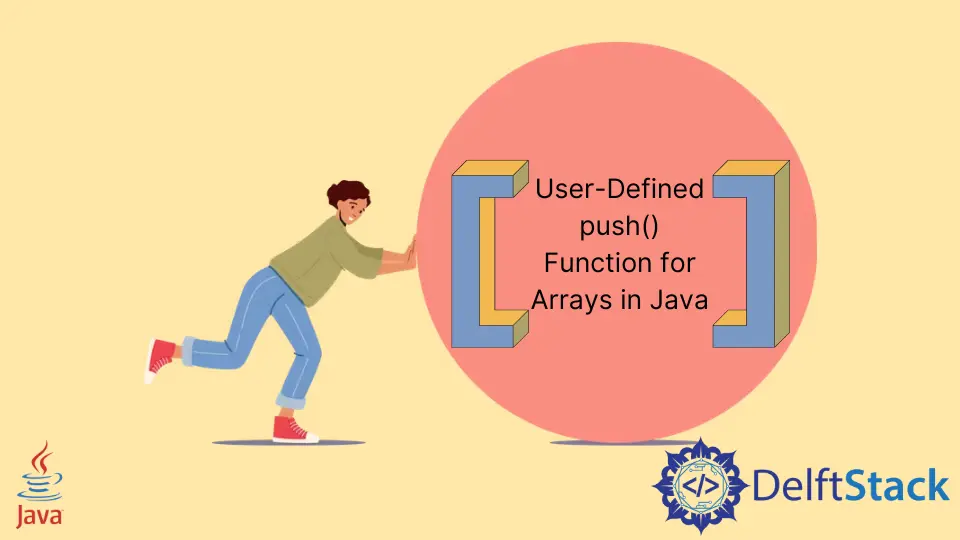Java 中的 push() 函数
Siddharth Swami
2023年10月12日
Java
Java Array
-
在 Java 中使用
stack.push()函数 -
在 Java 中使用
LinkedList.push()函数 -
在 Java 中使用
ArrayList.add()函数 -
在 Java 中为数组使用用户定义的
push()函数

如果我们谈论 push() 函数的基本定义,它将是一个将元素插入到某个结构末尾的函数。此函数与后进先出结构(如堆栈、链表等)相关联。Java 中没有用于数组的 push() 函数。
由于 push() 函数与数组无关,我们可以使用已经支持该函数的不同数据结构。
本文将讨论 Java 中的 push() 函数。
在 Java 中使用 stack.push() 函数
我们可以使用 stack 类中的 push() 函数。为此,我们将导入 java.util 包以使用堆栈类。
使用此函数,我们可以将元素添加到堆栈的末尾。堆栈可以是某种所需的类型。
我们将创建字符串类型的堆栈方法。我们将使用 push() 函数一一添加元素。
请参阅下面的代码。
import java.util.*;
public class Push_Example {
public static void main(String args[]) {
Stack<String> st = new Stack<String>();
st.push("Ram");
st.push("shayam");
st.push("sharma");
System.out.println("Stack Elements: " + st);
st.push("monu");
st.push("sonu");
// Stack after adding new elements
System.out.println("Stack after using the push function: " + st);
}
}
输出:
Stack Elements: [Ram, shayam, sharma]
Stack after using the push function: [Ram, shayam, sharma, monu, sonu]
在 Java 中使用 LinkedList.push() 函数
在 Java 中,push() 函数也与链表相关联。为此,我们将导入 java.util 包。
我们可以使用 LinkedList 方法定义一个新的链表。现在,我们可以使用 push() 函数一一添加元素。
例如,
import java.util.*;
public class Push_Example {
public static void main(String args[]) {
LinkedList<Integer> li = new LinkedList<>();
li.push(10);
li.push(11);
li.push(12);
li.push(13);
li.push(14);
System.out.println("LinkedList Elements: " + li);
// Push new elements
li.push(100);
li.push(101);
System.out.println("LinkedList after using the push function: " + li);
}
}
输出:
LinkedList Elements: [14, 13, 12, 11, 10]
LinkedList after using the push function: [101, 100, 14, 13, 12, 11, 10]
在 Java 中使用 ArrayList.add() 函数
对于 ArrayLists,我们可以使用 add() 函数来模拟 push() 函数。此函数将在给定 ArrayList 的末尾添加一个元素。
例如,
import java.util.*;
public class Push_Example {
public static void main(String args[]) {
ArrayList<Integer> li = new ArrayList<>();
li.add(10);
li.add(11);
li.add(12);
li.add(13);
li.add(14);
System.out.println("ArrayList Elements: " + li);
// Push new elements
li.add(100);
li.add(101);
System.out.println("ArrayList after using the add function: " + li);
}
}
输出:
ArrayList Elements: [10, 11, 12, 13, 14]
ArrayList after using the add function: [10, 11, 12, 13, 14, 100, 101]
在 Java 中为数组使用用户定义的 push() 函数
Java 中没有用于数组的 push() 函数。但是,我们可以创建一个函数来模拟这一点。该函数将把数组内容复制到一个长度更长的新数组中,并将新元素添加到这个数组中。
请参阅下面的代码。
import java.util.*;
public class Push_Arr {
private static String[] push(String[] array, String push) {
String[] longer = new String[array.length + 1];
for (int i = 0; i < array.length; i++) longer[i] = array[i];
longer[array.length] = push;
return longer;
}
public static void main(String args[]) {
String[] arr = new String[] {"a", "b", "c"};
arr = Push_Arr.push(arr, "d");
System.out.println("Array after using the push function: ");
for (int i = 0; i < arr.length; i++) System.out.println(arr[i]);
}
}
输出:
ArrayList after using the add function:
a
b
c
d
这个方法给出了想要的输出但是很少使用,因为它运行一个循环来复制数组元素,所以在处理更大的数组时会花费大量的时间和内存。
Enjoying our tutorials? Subscribe to DelftStack on YouTube to support us in creating more high-quality video guides. Subscribe